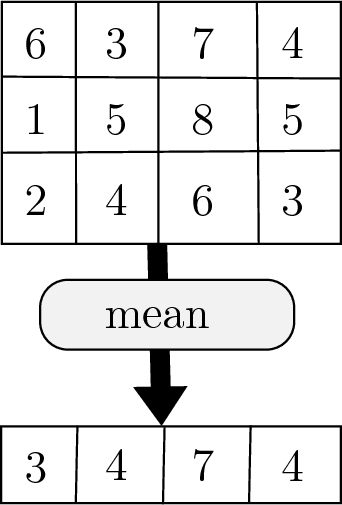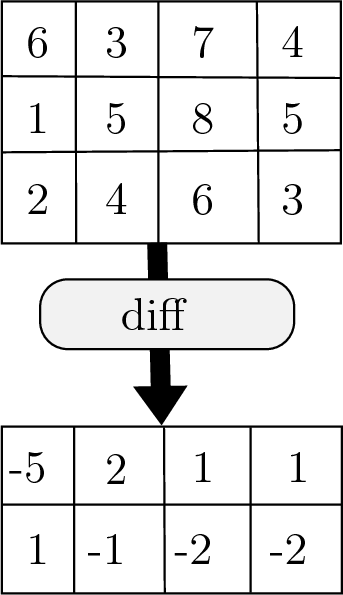4.6. Statistics on Matrices¶
4.6.1. Column Statistics¶
When a matrix is passed to a statistical function, the default is to work on each column of the matrix independently. The result is a row vector, which may in turn be used with other statistical functions if desired.

Fig. 4.12 The of a matrix is a row vector containing the means of each column.¶
Some functions return multiple values for each column. For example, the
diff function calculates the difference between adjacent elements in
each column of the input matrix. The cumsum function also returns a
matrix rather than a row vector.

Fig. 4.13 The diff of a matrix is a matrix with one less row holding the differences between the elements of each column.¶
4.6.2. Changing Dimension¶
Many statistical functions accept an optional dimension argument that specifies whether the operation should be applied to the columns independently (the default) or to the rows.
If matrix \(\bf{A}\) has size \(10{\times}20\), then
mean(A,2) returns a 10 element column vector; whereas, mean(A)
returns a 20 element row vector.
Some functions, such as min, max, and diff, use the second
argument for other purposes, which makes dimension the third argument.
To skip the second argument, use a pair of empty square brackets for an
empty vector, [].
>> Amin = min(A,[],2);
4.6.3. Covariance and Correlation¶
Covariance shows how distinct variables relate to each other. It is calculated in the same manner that variance is calculated for a single variable. Variance (square of the standard deviation) is the expected value of the squared difference between each value and the mean of the random variable. Similarly, the covariance between two variables is the product of the differences between samples and their respective means.
Thus, the covariance between a variable and itself is its variance, \(s_{xx} = s_x^2\). Covariance is represented with a symmetric matrix because \(s_{xy} = s_{yx}\). The variances of each variable will be on the diagonal of the matrix.
For example, consider taking a sampling of the age, height, and weight of \(n\) children. We could construct a covariance matrix as follows.
The correlation coefficient of two variables is a measure of their linear dependence.
A matrix of correlation coefficients has ones on the diagonal since variables are directly correlated to themselves. Correlation values near zero indicate that the variables are mostly independent of each other, while correlation values near one or negative one indicate positive or negative correlation relationships. Correlation coefficients are generally more useful than covariance values because they are scaled to always have the same range (\(-1 \leq r \leq 1\)).
The MATLAB functions to compute the covariance and correlation
coefficient matrices are cov and corrcoef. In the following
example, matrix \(\bf{A}\) has 100 random numbers in each of two
columns. Half of the value of the second column comes from the first
column, and half comes from another random number generator. The
variance of each column is on the diagonal of the covariance matrix. The
covariance between the two columns is on the off-diagonal. The
off-diagonal of the matrix of correlation coefficients shows that the
two columns have a positive correlation.
>> A = 10*randn(100, 1);
>> A(:,2) = 0.5*A(:,1) + 5*randn(100, 1);
>> Acov = cov(A)
Acov =
94.1505 50.0808
50.0808 50.6121
>> Acorr = corrcoef(A)
Acorr =
1.0000 0.7255
0.7255 1.0000
